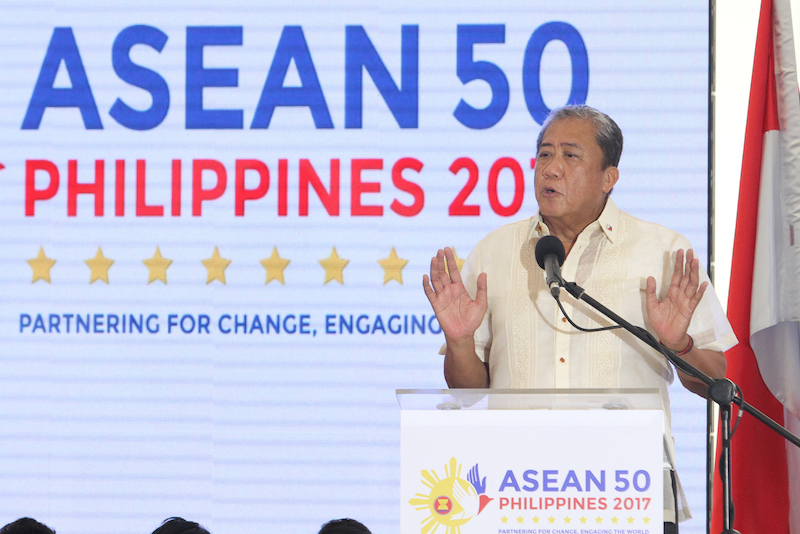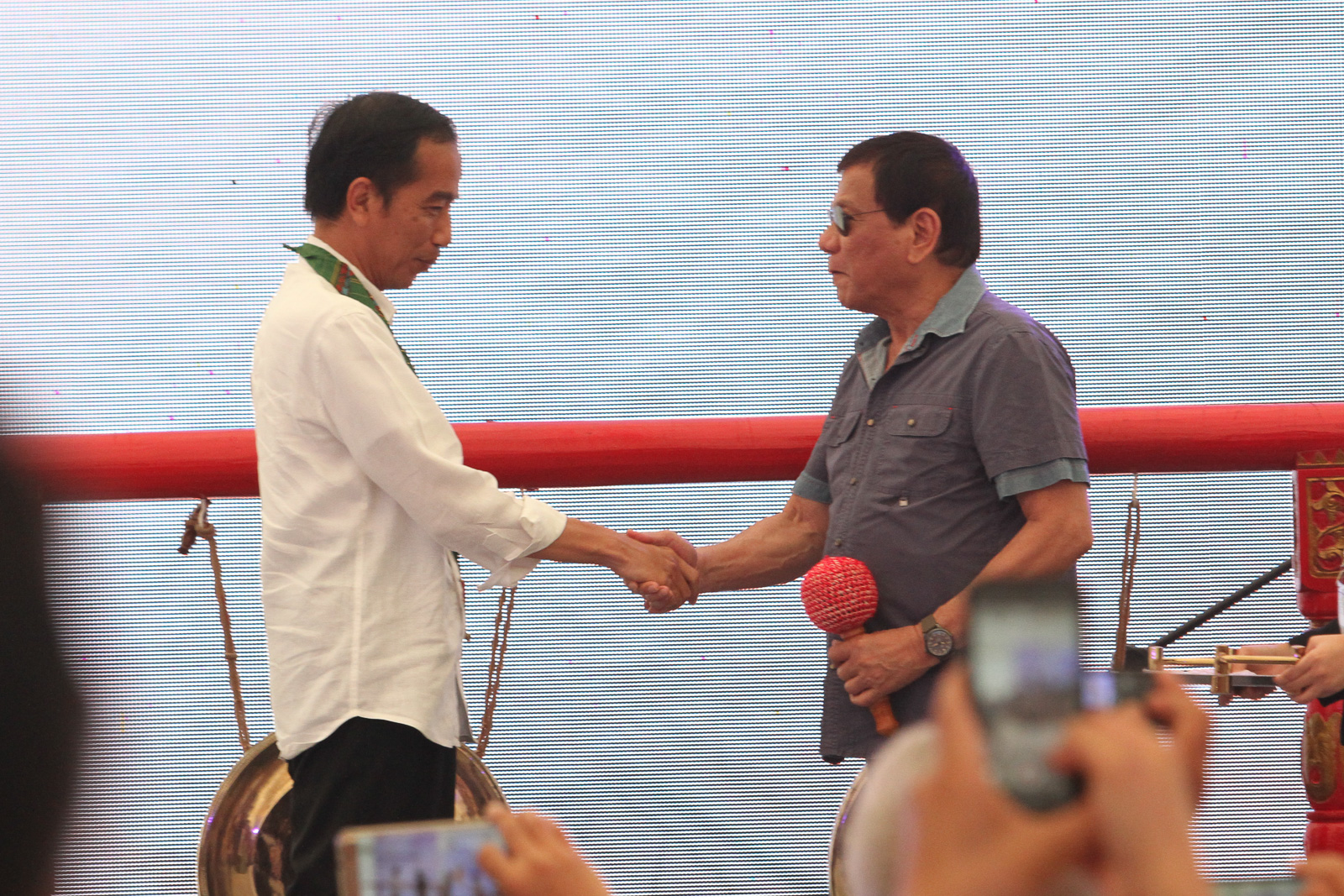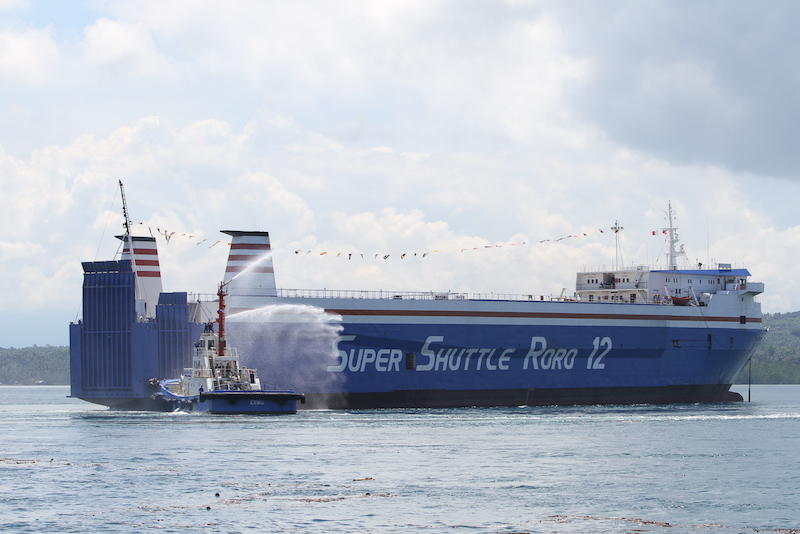DAVAO CITY (MindaNews / 30 April) — Transportation Secretary Arthur Tugade cited three ingredients to ensure the sustainability of the Davao-General Santos-Bitung roll on roll off (RoRo) route launched Sunday by Presidents Rodrigo Duterte of the Philippines and Joko Widodo of Indonesia: safety and security in the high seas, sustained volume of business; and customer satisfaction over transparent transactions.
Tugade said these three must be assured in the drive for connectivity and mobility within the ASEAN (Association of South East Asean Nations).
 Transportation Secretary Arturo Tugade says safety, volume of business and transparency are key to the sustainability of the Davao-GenSan-Bitung shipping route. MindaNews photo by MANMAN DEJETO
Transportation Secretary Arturo Tugade says safety, volume of business and transparency are key to the sustainability of the Davao-GenSan-Bitung shipping route. MindaNews photo by MANMAN DEJETO
“No development in the ASEAN can push ahead without mobility and connectivity,” he said.
As soon as the two Presidents struck the gongs at 10:10 a.m. at the Kudos port here to formally launch the route, M/V Super Shuttle RoRo 12, operated by Asian Marine Transport Corporation, blew its horn to mark the historic event, witnessed by dignitaries from both countries.
The ship left right away and is expected to be welcomed with another ceremony in the Indonesian city of Bitung in North Sulawesi when it docks there on May 2.
Tugade noted that 70 percent of products traded in the region are moved by sea. He described the RoRo shipping service as a “logistics network” and doing “magic” in the vision to ensure connectivity and mobility between the two countries by cutting shipment time from four to five weeks to 1.5 to two days.
The usual route to Bitung from Davao is via Manila and Jakarta.
But he noted that the structure facilitating the shipping service should be accompanied by the three ingredients to ensure the project will not be short-lived.
Before Sunday’s launch, at least two attempts have been made to trade using this route but they were not sustained.
Eternal vigilance
Tugade stressed the need for safety and security in the high seas, adding that the just-concluded 30th ASEAN Leaders’ Summit “paid attention by addressing the issue of piracy.”
Duterte in his opening statement at the ASEAN Leaders’ Summit on April 29, underscored the need for a regional effort to eliminate security threats, including violent extremism and terrorism.
He said piracy and armed robbery against ships disrupt the stability of regional and global commerce. “Eternal vigilance is the price that governments must pay to ensure safety of citizens,” he said.
 Indonesian President Joko Widodo and President Rodrigo Duterte shake hands at the launch of the Davao-Gensan-Bitung ASEAN RORO Route on 30 April 2017 at Kudos Port, Sasa, Davao City. MindaNews photo by MANMAN DEJETO
Indonesian President Joko Widodo and President Rodrigo Duterte shake hands at the launch of the Davao-Gensan-Bitung ASEAN RORO Route on 30 April 2017 at Kudos Port, Sasa, Davao City. MindaNews photo by MANMAN DEJETO
“We can only achieve this through advancing cooperation at the bilateral, regional and multilateral levels,” Duterte added.
Two Philippine Navy vessels accompanied the ship on its inaugural voyage. The vessels, however, will accompany the ship only up to Philippine waters as Indonesian vessels will meet them in their territory.
“Without safety and security, this project will be a goner,” said Tugade, a lawyer and businessman before he was appointed to a government post. Tugade, Duterte’s classmate in Law school, started with a forwarding business and later became a consolidator before branching out into farming, fuel distribution, trucking, travel, among others.
Tugade also emphasized the need for sustained volume of goods that will be moved from both countries to ensure sustainability of the shipping route.
He said the ministries of Trade and Industry of both countries are finding ways and means to assure the volume.
One percent cargo load
The Super Shuttle RoRo has a total capacity of 500 TEU (twenty-four equivalent unit). But it left Kudos Port for Bitung loaded with only five TEU or only one per cent of its total capacity. (see other story)
Datu Abulkhayr Alonto, chair of the Mindanao Development Authority (MinDA0 said the shipping service strengthens trading between the two countries and supports the goals of the other pillars of the BIMP-EAGA (Brunei-Indonesia-Malaysia-Philippines East ASEAN Growth Area): agribusiness, tourism, and socio-cultural and education.
Alonto called on industry and business players to participate in the initative and take advantage of the business opportunities provided by the route as he cited that the support from the private sector is critical to the sustainability of the project.
 President Rodrigo Duterte and Indonesian President Joko Widodo launched the Davao-Gensan-Bitung ASEAN RORO Route on 30 April 2017 at Kudos Port, Sasa, Davao City. MindaNews photo by MANMAN DEJETO
President Rodrigo Duterte and Indonesian President Joko Widodo launched the Davao-Gensan-Bitung ASEAN RORO Route on 30 April 2017 at Kudos Port, Sasa, Davao City. MindaNews photo by MANMAN DEJETO
Trade and Industry Secretary Ramon Lopez said the RoRo service is one of the economic priority deliverables for better connectivity and economic integration.
He said President Duterte saw a great potential in the route and committed to support it for BIMP-EAGA during his first ASEAN summit in Laos in September 2016.
Lopez added that the Philippines and Indonesia have become co-shepherds of the RoRo network for maritime connectivity in the region.
He said the launching should mean broader expansion of trade in the region citing the example of the Philippine-Indonesian trading. Indonesia is the Philippines 9th biggest trading partner – its Top 14 export market and Top 8 import supplier in 2016. He said they are eyeing a double digit trade growth with the launching of the RoRo service from last year’s four per cent.
MSMEs
Lopez also noted that the route is expected to spell a difference among MSMEs (micro, small and medium enterprises) that will consider trading in ASEAN due to the lower cost of transportation and trade.
Before his appointment as Trade Secretary, Lopez was Executive Director of Go Negosyo, the advocacy of the Philippine Center for Entrepreneurship (PCE), a non-stock, non-profit organization that advocates for a change in mindset and attitude, believing that Filipinos can address poverty by engaging in entrepreneurship.
Lopez said MSMEs in the tourism industry will also benefit from the opportunities opened by the shipping service.
He said the shipping route will not only strengthen bilateral trade between Indonesia and Philippine but also support greater integration in the ASEAN region.
On customer satisfaction, Tugade explained the need to “pay attention to the details of processing time.” He added that immigration and customs officials from both countries are checking the process it is shortened, transparent and accountable.
Vision 2025
According to the BIMP-EAGA Vision 2025, enhancing connectivity is one of the five strategic pillars of the BIMP-EAGA Development Path 2025.
The transport sector strategy is for “interconnected, seamless and safe multimodal transportation in the sub-region”. Among the identified challenges include transport connectivity, varying levels of development, differences in priorities and standards and lack of effective promotion of BIMP-EAGA in trade, tourism and investment.
The Vision 2025 document also identified key implementation bottlenecks to include policy and regulatory differences, poor coordination between sectors and national to local governments, and weak convergence at project levels.
The other sectors are food basket, tourism, environment and socio-cultural strategic pillars.
Perla Rubio, owner of the Malaybalay Choice Crafts, exporter of fashion accessories developed from locally-produced Abaca cloth welcomed the opening of the route.
She said this will truly help micro small and medium enterprises like hers to explore the market in the BIMP-EAGA.
But she said there should be more coordination between national and local government agencies. She added that it is local governments that are more accessible to MSMEs in the communities, especially in the rural areas. (Walter I. Balane for MindaNews)
(This story was produced under the Reporting ASEAN program and media series implemented by Probe Media Foundation, supported by an ASEAN-Canada project, funded by the Government of Canada. It is also in partnership with AirAsia, and in collaboration with the ASEAN Foundation)
